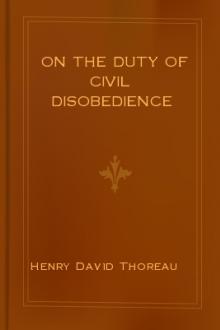Essays Henry David Thoreau (little bear else holmelund minarik .txt) 📖

- Author: Henry David Thoreau
Book online «Essays Henry David Thoreau (little bear else holmelund minarik .txt) 📖». Author Henry David Thoreau
Here a more copious air invests the fields, and clothes with purple light; and they know their own sun and their own stars. ↩
In this description of Virtue, Thoreau made some use of the MS. afterward printed in Mr. Sanborn’s edition, in which he quoted the same passage from Sir Thomas Browne, but without giving the author’s name. A portion of the illustration of the clarion and corselet is also found in “The Service.” That this whole Ralegh sketch was given as a winter lecture in the Concord Lyceum is rendered probable by his speaking hereof “waiting for warm weather,” and of a winter campaign. If the records of that Lyceum were complete we might find the very evening on which he read it there—not later, I am sure, than 1845. —F. B. Sanborn ↩
The wife of Judge Russell. ↩
The selectmen of the town, not knowing but they had authority, refused to allow the bell to be tolled on this occasion. ↩
Translated by Mr. Thoreau. ↩
The lighthouse has since been rebuilt, and shows a fresnel light. ↩
Hierosme Lalemant says in 1648, in his relation, he being Superior: “All those who come to New France know well enough the mountain of Notre Dame, because the pilots and sailors, being arrived at that part of the Great River which is opposite to those high mountains, baptize ordinarily for sport the new passengers, if they do not turn aside by some present the inundation of this baptism which one makes flow plentifully on their heads.” ↩
From McCulloch’s Geographical Dictionary we learn that “immediately beyond the Island of Orleans it is a mile broad; where the Saguenay joins it, eighteen miles; at Point Peter, upwards of thirty; at the Bay of Seven Islands, seventy miles; and at the Island of Anticosti (about three hundred and fifty miles from Quebec) it rolls a flood into the ocean nearly one hundred miles across.” ↩
Sherborne came into Ralegh’s possession in 1592. —Ed. ↩
This poem (also called “The Lie” and “The Farewell”) has been given as written by Sir Walter Ralegh, the night before his execution, which was October 29, 1618; but it had already appeared in Davison’s Rhapsody, in 1608; and it is also to be found in a MS. collection of poems in the British Museum, which has the date of 1596. With the title, “The Lie,” it is printed by Davison with many variations, e.g.—
Say to the court it glows,
And shines like rotten wood, etc., etc.—
↩
ColophonEssays
was compiled from essays written between 1840 and 1862 by
Henry David Thoreau.
Threadable
sponsored the production of this ebook for
Standard Ebooks.
It was produced by
Vince Rice,
and is based on a transcriptions produced between 1993 and 2020 by
Charles Bidwell, Jason Filley, Steve Mattern,
Melissa McDaniel, Q. Myers, Sameer Parekh,
Vince Rice, David Widger, Wikisource,
and The Online Distributed Proofreading Team
for
Project Gutenberg (The Service and others), Wikisource (Aulus Persius Flaccus and others), and The Walden Woods Project (After the Death of John Brown)
and on digital scans available at
Google Books (Aulus Persius Flaccus and others),
the Internet Archive (The Service and others), and
the HathiTrust Digital Library (Democratic Review and others).
The cover page is adapted from
West Wind, Algonquin Park,
a painting completed in 1917 by
Tom Thomson.
The cover and title pages feature the
League Spartan and Sorts Mill Goudy
typefaces created in 2014 and 2009 by
The League of Moveable Type.
The first edition of this ebook was released on
May 11, 2021, 9:19 p.m.
You can check for updates to this ebook, view its revision history, or download it for different ereading systems at
standardebooks.org/ebooks/henry-david-thoreau/essays.
The volunteer-driven Standard Ebooks project relies on readers like you to submit typos, corrections, and other improvements. Anyone can contribute at standardebooks.org.





Comments (0)